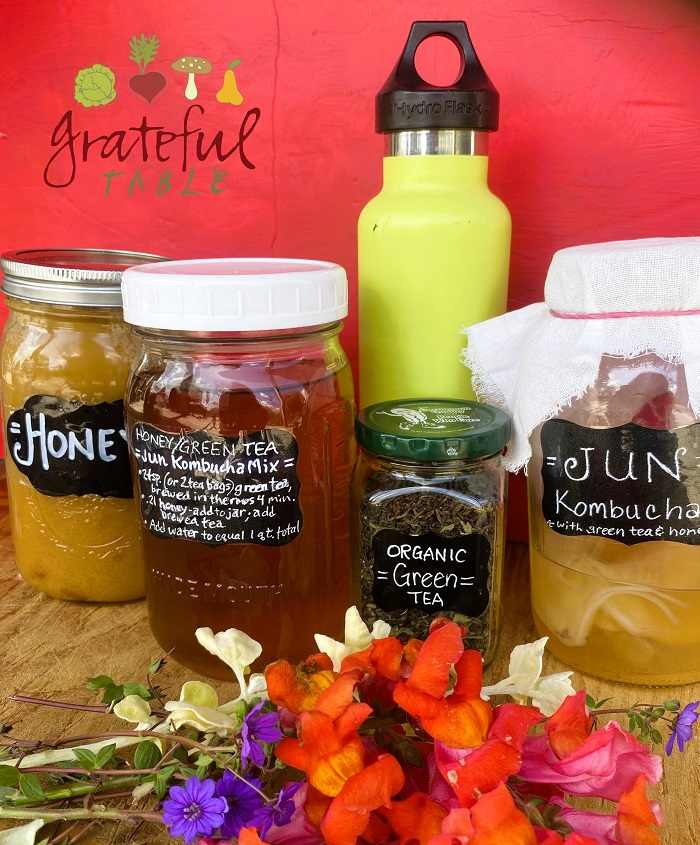My old kombucha recipe (posted here) needed an update- I posted that recipe eight years ago! And in case you forgot why you want to drink probiotics, I did sum that up in an article here.
I realized my recipe was a bit dated when giving son Tyler’s new bride Maria a box of fermentable projects. I’m so glad she was interested- Maria even tried (and wanted some of) my Natto (which is more than I can say for most every other guinea pig around here besides husband Tom!).
So I was inspired to get this update out. I hope it helps anyone trying to maintain their kombucha overflow without drowning in gallons of kombucha vinegar. I started making this smaller amount when our kombucha habits changed- the grandkids switched to Kefir (recipe here), as it doesn’t have any caffeine, and now Tom and I drink that a lot, since I’m already making it for them.
But I want to keep my scoby happy, even while ignoring it a bit. Below is a quart-size recipe for Jun kombucha, along with a few extra tips to (hopefully) maintain Jun kombucha for one or two people.

Start with a bit of Jun starter (on Amazon, here) (or get some from me personally- comment below!). Add about as much of the honey-sweetened green tea mixture as you anticipate needed in the upcoming week. If I know I need less than a cup or so for drinking in the upcoming week, and just want to keep the scoby happy, I only feed a small amount of starter (maybe just a 1/3 c. or so), with only a cup or so of the sweetened tea.
A week later, I have some fermented Jun kombucha, that I can add to smoothies or drink straight. (I reserve some of the kombucha as starter, to add more sweet tea to.)
If I skip drinking any that week, I have something much tarter than Jun by the second week. Still full of probiotics though!
Ditto the third week- if I haven’t used any of the kombucha, and haven’t fed it any fresh sweetened tea mixture, it starts approaching vinegar status. You can let some of it continue fermenting until it tastes tangy enough, and just use it as you would vinegar. Vinegar’s still nutritious, containing acetic acid, which may have benefits like helping with blood pressure and fat accumulation. But vinegar’s not quite ideal for adding to smoothies or whatever, right?!
If your goal is to keep your Jun scoby happy and alive, while drinking smaller amounts of it, the recipe below should work.
JUN KOMBUCHA
INGREDIENTS
- 2 tsp. loose green tea (or 2 bags)
- 2 c. boiling water
- 2 c. ice water
- 1/3 c. (.21 lb.) honey (preferably raw, organic)
- 1/4 c. starter tea (or about 10%)
- Jun Scoby
PREPARATION
Brew the tea in a shatter-proof thermos, steeping 2-4 minutes in the thermos. Use: > 2 tsp. loose green tea > 2 c. or so boiling water
After steeping, strain tea (or remove bags), pouring it into a quart jar. Add honey and stir well: > 1/3 c. honey
Add enough ice (or water) to bring the liquid amount up to 4 c.
When the sweetened tea has cooled to room temperature, add it to about a 1/4 to 1/2 c. starter tea in the starter quart jar.
OR- only add a third or half of that sweetened tea to the jar with the starter in it. Save the extra sweetened tea in the refrigerator. Or freeze it if you’ll be ignoring your Jun for more than a week. That way, you can easily feed your starter again next week (or next month), using the extra sweetened tea. (I defrost the frozen sweet tea in the fridge for a few days.)
In any case, within a week (or less), the Jun kombucha will be tart enough to drink, and full of probiotics. Pour some off daily to drink or add to smoothies. Or get all fancy and pour most of the cultured kombucha into a ceramic-stopper-type bottle, adding fruit juices or what-have-you. Once you close the lid on the fancy bottle, it’ll start building up carbonation. “Burp” that kombucha daily, so it doesn’t get too carbonated. (We’ve wiped kombucha geyser remains off the ceiling many a time…) Store in the fridge once it’s tart/carbonated enough, which will slow down the fermenting/carbonating process.
A link to the original recipe is at the top of this page, if you need more directions. Please, leave a message below, if you have any questions, or any exciting success stories!
